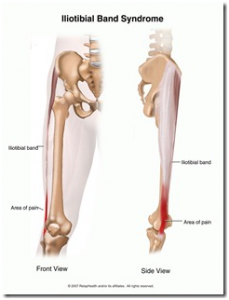If you’re a rider bothered by occasional to chronic hip and knee pain, read on. You may have ITBS, or Iliotibial Band Syndrome.
ITBS is a common ailment usually identified with running, probably because more people are runners than horseback riders. Skiers, bicycle riders and horseback riders often develop this problem as well. The knee is usually the first part of the body to complain, although in my case the hip is usually the problem area.
The ITB (Iliotibial Band) is a dense fibrous band running from the pelvis to the outside of the knee. It runs over the bony parts of the hip and the outside of the knee, and the rubbing of the band over bone is what causes the problem. The band can become irritated and inflamed, and the underlying bursa can also become swollen.
Some causes are leg length asymmetry, over/under pronation, running on hills and hard surfaces, knee instability, and weak muscles. For horseback riders, improper rotation of the leg can contribute. Riders are often told to point their toes forward–properly, you would rotate your entire leg from the hip until the foot is pointing forward, but not by breaking at the ankle to get the forward direction of the toe, or by twisting at the knee. The bend of the knee required for riding can be a setup for ITBS.
I developed ITBS several years ago while training for a marathon. While knee pain is the most common symptom, I developed pretty severe hip pain, probably as a result of being a bit too overweight for the amount of training I was doing, and running on country roads with no shoulder, which means I was on the banked part of the road, which meant my right leg was constantly higher than my left. The best treatment for ITBS is rest, which of course I didn’t do because I was training for a marathon. I ran the marathon and three days later, I got the more common knee pain in a very acute form–heat, swelling, and the feeling that someone had jabbed a knife in my knee. With the race completed, I got the needed rest, and the knee pain thankfully went away, but I’ve had chronic hip pain ever since.
I’ve recently started taking dressage lessons and in many ways am starting all over with my riding. Nobody would call me a natural athlete, so I’d doing a lot of trial and error in my quest to do this correctly. I’d guess I’m riding 80% incorrectly, and my ITBS has flared up with a vengeance, causing quite a bit of pain from my hip all the way down to my ankle. Yes, the ITB goes from your hip to your knee, but since it pulls on your knee when you have ITBS, a muscle called the peroneals now goes into a spasm, and that runs from your knee to your ankle.
What to do? Prevention, as always, is the best course of action, and that means stretching, maintaining fitness, and being conscious of how your are using your body, maintaining correct alignment and avoiding overstress of your leg and knee. Of course, if you’re reading this, it may be safe to assume that it’s too late for prevention. Rest is the next best step–if you develop symptoms, try to identify what you’re doing to cause the problem, and STOP DOING IT! You may need to discontinue riding for a bit to give your leg a chance to heal. And if it’s too late for that, the traditional measures of ice and anti-inflammatories, combined with rest, will help. The best technique I’ve found, though, is a few forms of self-massage involving a tennis ball and a form roller. You can usually find muscle spasms along the band (press on various parts of the outside of your leg from hip to knee, and it shouldn’t take you long to identify the problem areas). The tennis ball is helpful for hip areas–lie on your side with the tennis ball pressing on the spasm and roll over the ball, helping the spasm to break up. The foam roller is useful for spasms on the outside of the thigh. This is going to hurt, so grit your teeth and do what you can! I’ve found, though, that this is the fastest way to get some relief from the pain and tightness.
Keep in mind that I AM NOT A DOCTOR OR ANY KIND OF MEDICAL PROFESSIONAL and you should check with your medical professional before doing any kind of diagnosis or self-treatment.
Runners World has some good information and stretches on their website: http://www.runnersworld.com/tag/itbs-iliotibial-band-syndrome

